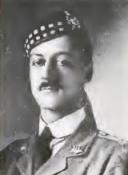
|
The King's School Canterbury |
Roll of Honour |
| Captain Harold Mackenzie DEANS | |
|
2nd Battalion King's Own Scottish Borderers attached to the 7/8th (Service) Battalion Date of birth: 29th March 1894 Date of death: 17th September 1918 Killed in action aged 24 Buried at Philosophe British Military Cemetery Plot III, Row F Grave 24 |

|
| He was born at 18 Minet Avenue, Willesden on the 29th of March 1894 the son of John Deans, an optician, and Nina Anne (nee Row) later of 4 Beaumont Terrace, Poole, Bournemouth. He was christened at All Souls Church, Harlesden on the 10th May 1894. He was educated at Bournemouth School from January 1907 to July 1908 and at the King's School Canterbury from September 1908 to July 1911. He matriculated for Edinburgh University in January 1912 where he studied medicine from the 15th of April 1912 to 1914. He was a member of the Officer Training Corps from the 17th of April 1913. He was commissioned as a 2nd Lieutenant in Edinburgh University Officer Training Corps on the 6th of August 1913 in the infantry unit of the Officer Training Corps Contingent. Following the outbreak of war he applied for a commission on the 6th of August 1914 in an application in which he expressed a preference for the Cameron Highlanders. He underwent a medical examination at Edinburgh on the 13th of August 1914 where it was recorded that he was six feet one and a quarter inches tall and that he weighed 159lbs. He was commissioned as a probationary 2nd Lieutenant on the Unattached List of the Territorial Force in the 3rd Battalion of the King’s Own Scottish Borderer on the 15th of August 1914. He was posted to France, landing there on the 25th of September and was posted to the 2nd Battalion of his regiment. He was wounded at La Bass?e in November 1914 and was taken to hospital at Bethune. While he was there the Germans shelled the hospital and a number of patients were killed. He was confirmed in the rank of 2nd Lieutenant on the 2nd of January 1915 and was promoted to Lieutenant in February 1915. He returned to France in March 1915 and was promoted to Captain on the 25th of April 1915. He was wounded once again on the 30th of April 1915 when his battalion attacked Hill 60. He returned to France less than two months later. He served in the trenches through the winter of 1915/16 during which time he contracted trench fever and was eventually evacuated home. While he was recovering he took a course in gas in Scotland and was married in 1916 to Helen Margaret (nee Dickson); she lived at "Gowanlea", 10 Hyndford Road, Lanark in Scotland. He was appointed as an Assistant Instructor in Gas to the British Military Mission to America on the 14th of November 1917 and returned from the United States to France with the 79th Division, American Expeditionary Force in July 1918. He was offered an instructors job for six months on his return but he was feeling in much better health, so refused it saying: - "It would not be playing the game to take on another "soft job" when fit men are wanted so badly at the front." He returned to France on the 24th of August 1918 where he was attached to the 7/8th Battalion of his regiment. On the 5th of September he gave a lecture to the battalion NCOs on protection against gas. On the 14th of September 1918 A and B Companies from the battalion were withdrawn to Mazingarbe to practice for a raid on an enemy trench system near Loos which was scheduled for the afternoon of the 17th of September. Harold Deans was to lead the raiding party, the objective of which was to take prisoners and to establish the enemy strength. The advance was to be half a mile with the final objective being Hulluch trench. At 3.45pm on the 17th of September 1918 the raiding party was in position for the attack and at 4pm the covering artillery barrage and they advanced. They soon crossed the German first line and gained the support line, under "murderous" machine gun fire, where Deans established his headquarters. He then saw that his men were being held up on the right of the attack by heavy machine fire and running forward he rallied his men for a charge against next enemy trench. During this exchange Harold Deans and the bugler threw bombs to break up an enemy counterattack, killing a number of the enemy. It was during this stage of the attack that he was struck in the heart by a machine gun bullet and killed. Although the Divisional records record the raid a "success", no prisoners were taken and 25 Germans were killed of whom 11 were killed by the artillery before the advance began. Most of the casualties were suffered in heavy fighting around the final objective. Total casualties among the raiders were three officers killed with three wounded and eight other ranks killed with thirty nine wounded and seventeen missing. His wife received the following telegram dated the 21st of September 1918: - "Deeply regret Capt. H.M. Deans KOSBs killed in action September seventeenth. Army Council express sympathy." He is commemorated on the war memorial at Edinburgh University and on the memorial at Bournemouth. |
|
Back